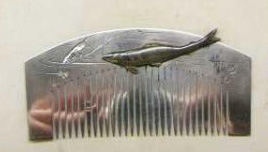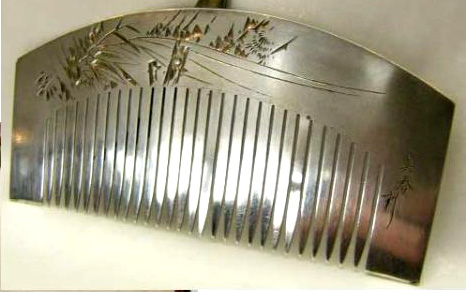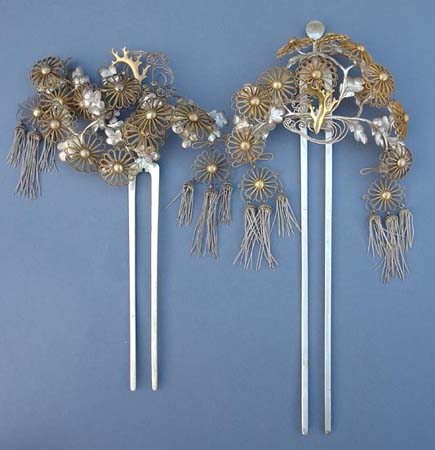I’m in the mood for the unusual today, so I thought I’d showcase a few combs that are flamboyant variations of the ones we usually see.
These silver and gold kanzashi from the Meiji era are over-the-top attachments to silver pins. They have 16-petal chrysanthemums, leaves, gold branches, and fringe. They were sold on Trocadero for a ridiculous price because I know this dealer. ;-) I didn’t buy them, though. :-(
This tortoiseshell comb boasts 3 carved shell cameos, one of Athena and two of Flora. It sold for $1295 on Ruby Lane, even with two slightly broken tines and a seperation in the scrolled ornamentation at the top. The dealer thought it was French, 1860. I am not sure. With the craze surrounding archeological discoveries that took over Victorian England, it might be English. I’m undecided, but I love it.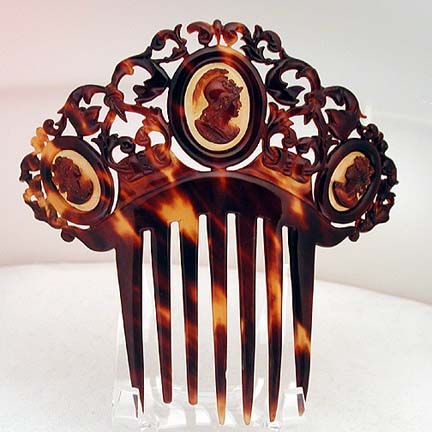
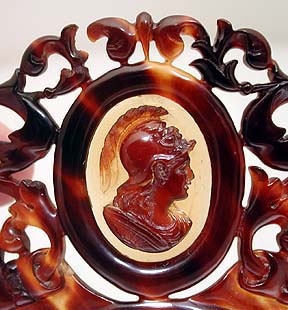
This one I am buying. It’s a Victorian Algerian, c. 1870. As aluminum was discovered in 1827, when this was made, the metal was more valuable than gold. Alas, today, the materials in this comb are worth about 35 cents, but I had never seen one like it, and I had to have it. :-) The leaves are acanthus leaves, after Cesar’s headpiece. The chains are silver, and the beads are turquoise-colored glass. I guess one wore this with a toga-like white gown.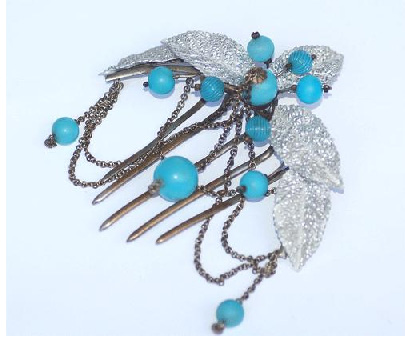
This Edo tortoiseshell comb with a silver- and gold-plated copper frame, decorated with coral beads, sold on ebay for $1000 on Oct 15.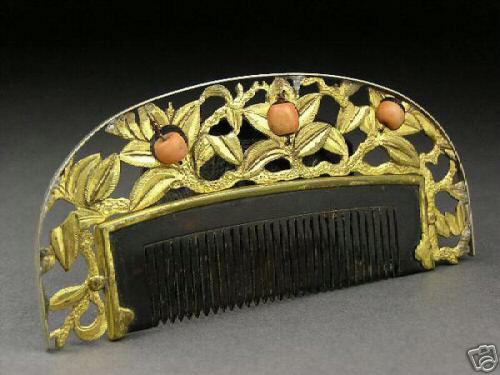
I thought this celluloid comb had humor and originality. It is English, c. 1890, and sold on ebay as part of a 7-piece lot.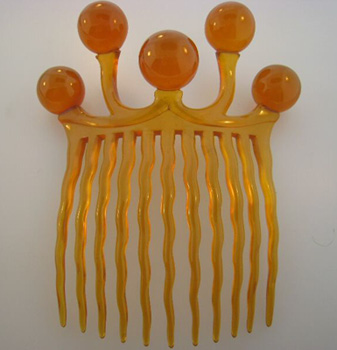
And last, becuase I must, a flamboyant 19th-century tiara of 18K gold with diamonds, emeralds, rubies, amethysts, garnets, and topaz. I loved all the colors. :-) It is available for sale at a jewelry store on Madison Ave. in Manhattan, which was featured in a NOVA special on diamonds, as having one piece of the French crown jewels.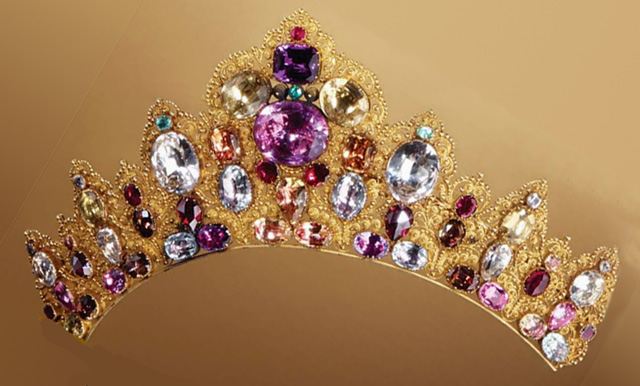
Metamorphosis
Metamorphosis, a poetic strategy whereby plants and animals fused with the human form, was commonly used in art nouveau jewelry, perhaps most famously by Rene Lalique. Jewelers created mystical creatures, who emerged from nature erotically, as leaves and dragonfly wings were teased into looking like parts of the body. In comb making, parts of an animal or human body were elongated into being functional parts of the comb.
This comb was the star of the Lalique / Japanese comb-comparison exhibit in Hakone, Japan. The museum wouldn’t send the catalog outside of Japan. I had to ask my friend Shigeru-san’s brother to get it for me and send it. But, oh my God. I never knew this comb existed.
It is an honor for me to present what I believe to be the first Internet images of Lalique’s comb, “Metamorphosis.” It is ivory, with gold trim, pearls on the gold. The trim is faceted to the ivory by nails on the side and gold loops ended by lapis hearts. In it, a woman is born out of leaves: Rodin on a comb, an astonishing marriage of art and functional design.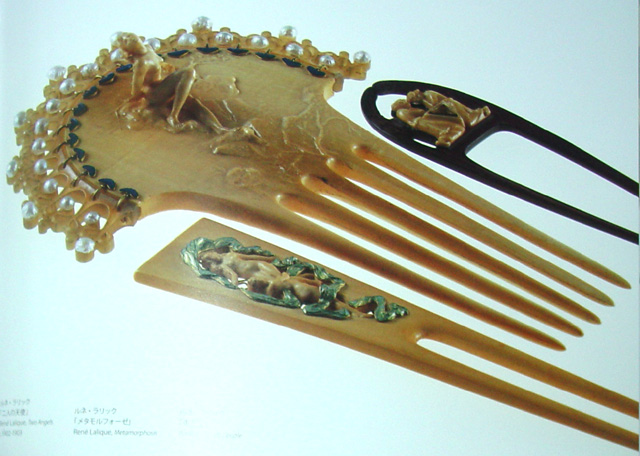
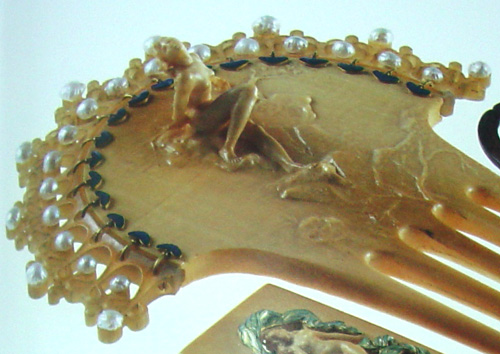
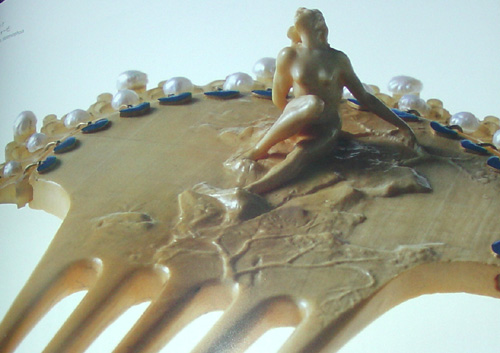
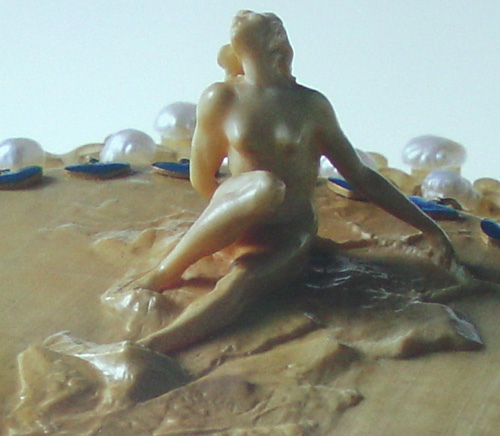
My Little Mystery
About a year ago, I bought this little ivory comb on Ebay for around $24. I liked it. It was unusual. No one else wanted it. So, c’est la. As I was researching the web one day, I came across this little interesting picture from the Victoria and Albert Museum in London. The picture was called “Designs for a Pendant and Comb.” The text read, “René Lalique (1860-1945), Design for a comb (right), Pen, ink and gouache, Museum no. E.838-1949. The comb was possibly designed to be made from ivory or horn. The latter is an unusual material for jewellery but one that Lalique made frequent use of, especially in his many ornamental combs.” Here was the drawing.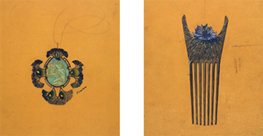
Here is what I bought.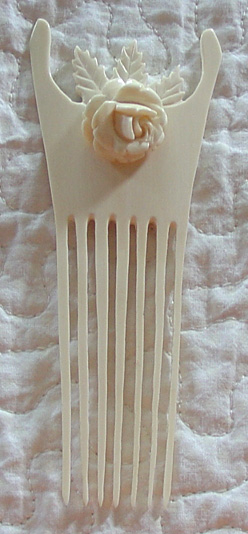

It has what I believe to be a Japanese signature. We know Lalique was heavily influenced by the Japanese comb makers. My little comb even has the same number of tines as the drawing. I have no idea if the maker ever saw Lalique’s drawing, but when I look at my comb, I am reminded of that wonderful children’s novel, “From the Files of Mrs. Basil E. Frankweiler.” It’s a mystery.
Some Lovely Things on Ebay
There have been some lovely things on ebay recently.
A wonderful 14K gold griffin on a silver base, attached to a tortoiseshell comb sold for $550 on Sept. 27. It has a diamond in its mouth, diamonds on the wings, and a ruby cabachon eye. You may refer to Item #170151496226.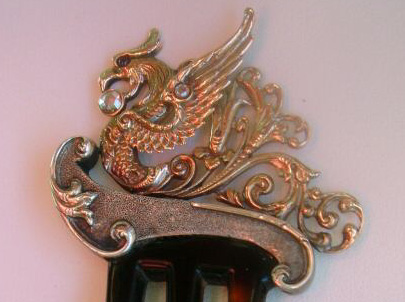
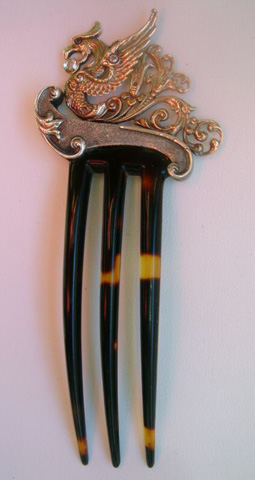
A beautiful Meiji silver-and-gold kanzashi set depicting a bowl, vase, and spoon sold for $465 on Sept. 26. Only one is pictured here so you can see the closeup. You may refer to Item #300153292268.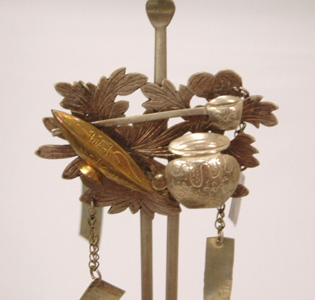
This Victorian garnet tiara hinged on a tortoiseshell comb just sold for $308 on Sept 24. Excellent price for such a lovely star-laden tiara design.You may refer to item #170150463040.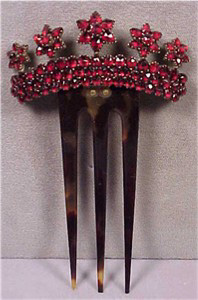
This beautiful Edo kogai stick sold for $660 on Sept 17. It is made of tortoiseshell and decorated with apricot flowers. If you look at the closeup, you can see that little bell flower with the pistels. These painted flowers have the same design as the carved flowers on both shell kanzashi, and the bakelite kanzashi from those Japanese wedding sets they made in the 1940s. You may refer to item #110168679851.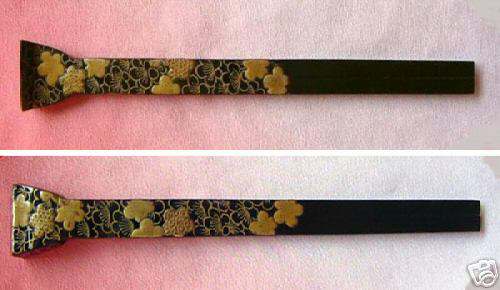
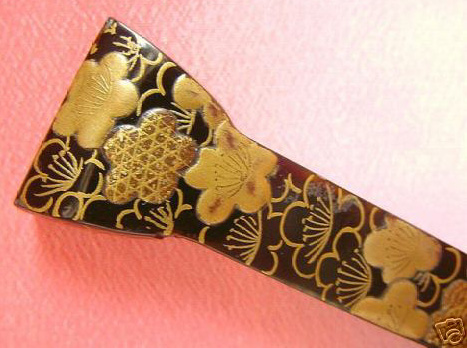
This ivory Edo kogai stick with gold maki-e paint and inlaid jade and coral sold for $300 on Sept. 17. You may refer to Item #330164680560.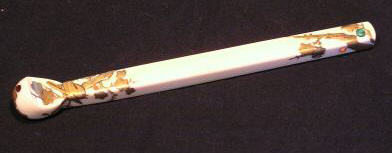
This lovely carved shell floral design on a Meiji set went for $152 on August 30. The stick in between the kogai pieces is wood. There are bug bites on the shell kushi, and that brings the price down considerably. In perfect condition, this would have gone much higher, but I thought $152 was an excellent price for this.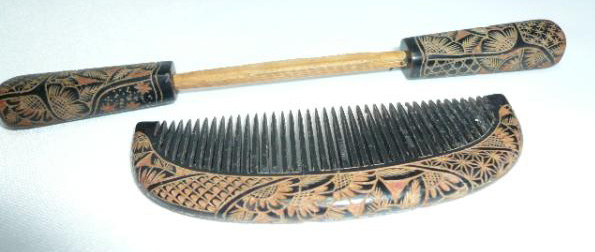
This is a gorgeous piece. The Meiji tortoiseshell kushi depicts waves and is inlaid with pearl. Excellent Condition. It sold for $646 on Sept 22. You may refer to Item #300151918225.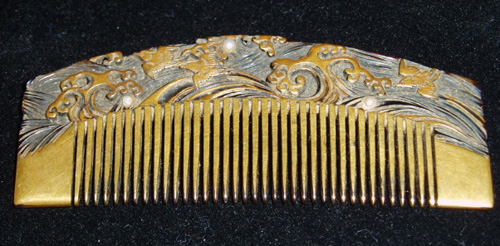
And finally, for today :-), this beautiful Victorian ivory comb sold for $355 (I lost, sadly) on Sept 21. You may refer to Item #290161590846.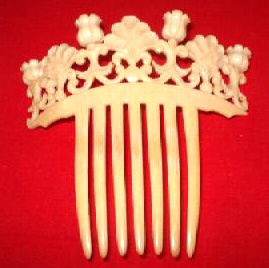
Broken Kanzashi, Broken Heart
Recently, I bought a real shell kanzashi for $214.50. Given the prices Japanese combs are going for on ebay now, I was thrilled to get a real shell kanzashi for a price I could afford. I begged the seller to wrap it properly. I told her a story of when I paid $600 for a real shell kanzashi from Kyoko at Trocadero. It was of a bat. She wrapped it in an envelope, and it came broken. I haven’t been able to find one I liked for what I could afford since then, maybe 3 years ago. Here is what I bought. Shipping cost for me? $14.
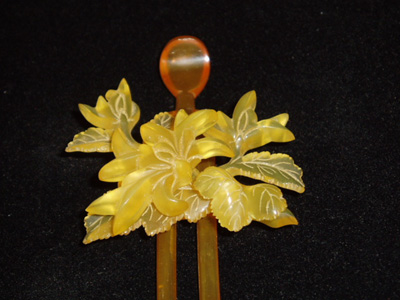
Here is how it arrived: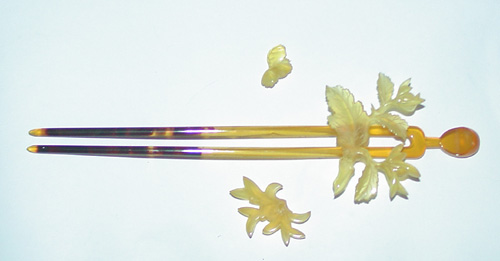
For $14 shipping, it was sent in the smallest-sized priority mail box, wrapped in a few sheets of bubble wrap, with a few popcorn things, and the actual piece was wrapped in what I believe is toilet paper. Sure, I’ll send it back and get a refund, but what the ****. Toilet paper? And a small box, when I begged them? I am just so furious at this moment I could scream. It was a beautiful art piece that survived 100 years in tact. Now, it’s ruined.
Holding Hands
One of the most beautiful innovations of art nouveau design occurs when an artist translates the relationships between animals and plants into a piece of jewelry: one flower petal leaning over to touch another, birds in an embrace. The relationship is then formed not only into art, but also into function. Here are two combs, which illustrate this beautifully.
On the left is a pair of fan-shaped leaves by Louis Aucoc, c.1900. They are made of green plique-à-jour enamel with small rose-cut diamonds in the veins. It sold for $32,400 on April 25, 2006, in New York. On the right, two silver cranes embrace to make this imaginative comb by Hugue. As you can see, the legs of the crane function as the comb, which sold for 1200 GBP on February 22, 2006 in London. Both came from Sothebys.
Some English Diamonds
Although conservative and tiara-like in design, diamond and shell Victorian and Edwardian combs are still breathtaking. I love them. Here are three that sold at Sotheby’s last year.
Pearl and Diamond hair comb; c. 1890; sold 13,200 GBP; 29, June, 2006; London.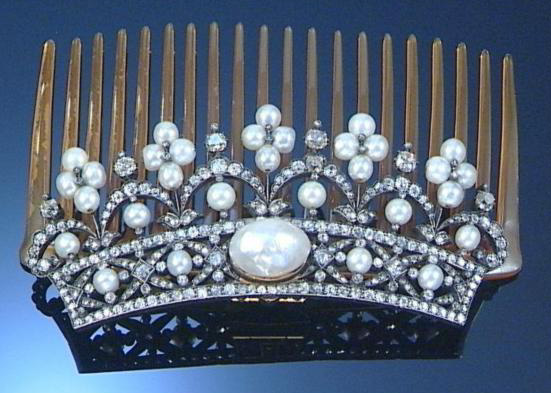
Diamond and blonde shell comb; c. 1910; sold 15,600 GBP; 15, December, 2006; London.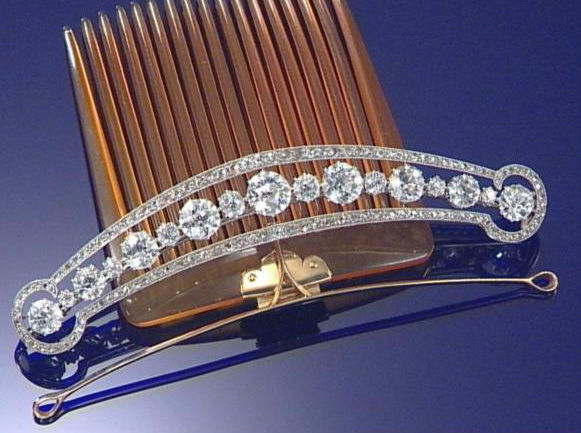
A golden eagle and serpent engaged in combat top this dark tortoiseshell comb, c. 1850. It is decorated with green and white enamel, and ruby and pearl highlights. Sold 3000 GBP; 29, June 2006; London.
Hair Comb Exhibit at the Lalique Museum in Hakone, Japan
After the opening up of trade routes to Japan, Edo combs were introduced at the Paris exhibition of 1867. They took the European art world by storm and began a craze in France called Japonisme . Western artists noticed the strong Japanese relationship with nature, which produced jewelry that was at once delicate and powerful. Rene Lalique was heavily influenced. He chose comb motifs (swallows, hanging wisteria) and materials (horn), which were common in Japan but shunned in Europe at the time.
It is interesting to compare his famous work Two Swallows with a Stalk of Oats c. 1906-1908, carved horn gold and diamonds, with a Meiji kanzashi of plover birds. In Swallows, Lalique takes the Japanese motif to a new level of inventive design and composition. 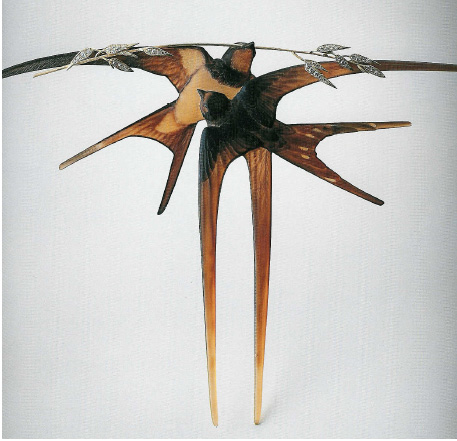
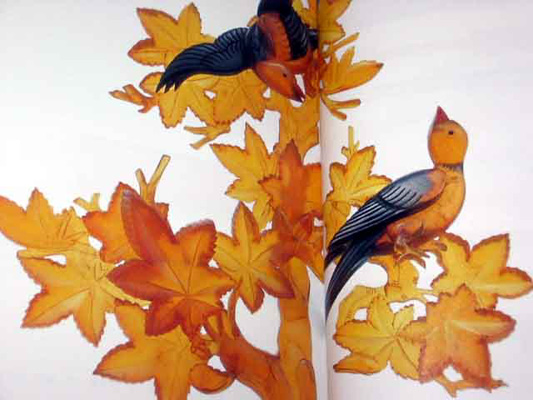
In this comb housed at the RijksMuseum in Amsterdam, Lalique makes Guelder rose flowers on stems of translucent horn. Apparently, they are so fragile that the flowers of diamond clusters seem to be bending the leaves.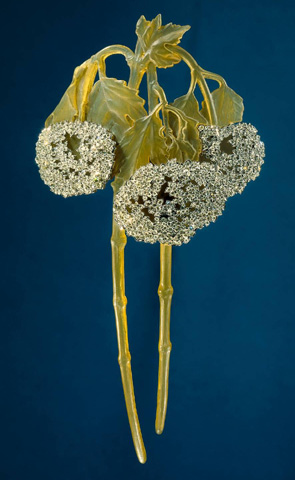
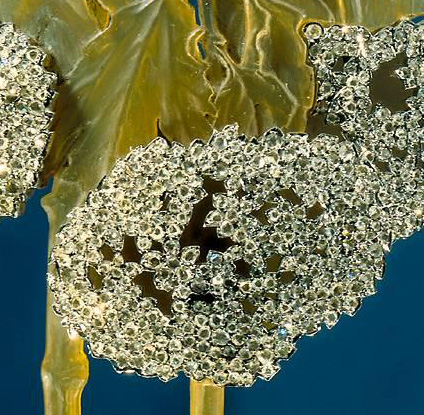
No Lalique post would be complete without an orchid. This one lives in a museum in Lisbon.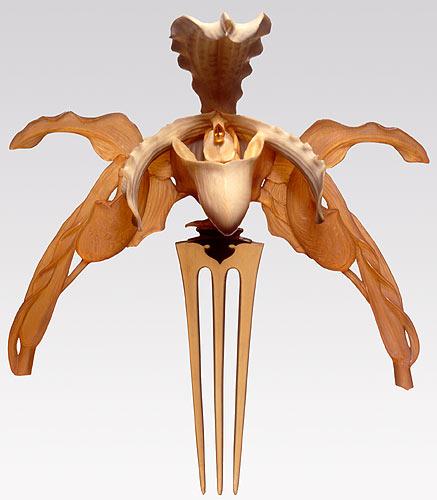
From June 23 to Nov 25 2007, The Lalique Museum in Hakone Japan will have a Special Exhibition: The Charm of Hair Ornaments – Lalique’s Combs and Japanese Traditional Kushi.” I don’t know that these particular pieces will be showcased, but there will be 20 Lalique combs made with his own hands on display. 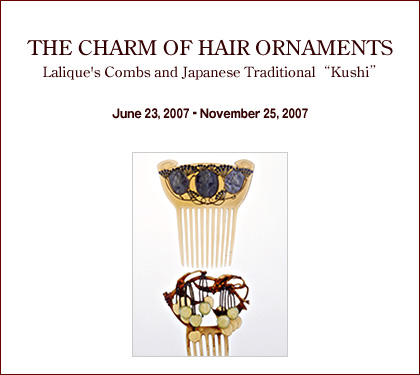
Father and Son
While Charles Lewis Tiffany’s jewelry store produced this diamond and shell comb (c.1910, sold Sothebys, 6,600 GBP, 30, March, 2006):
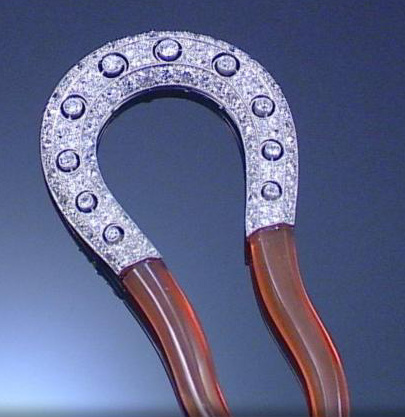
his son was changing the way the world thought about art, and made this:(Louis Comfort Tiffany comb, c. 1904, Metropolitan Museum of Art, priceless)
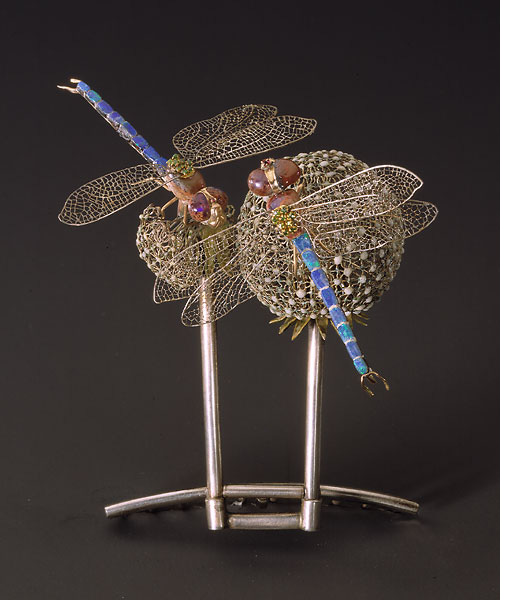
कंघी
For more scholarly research, please examine these books, which can be found in our Resource Library. I’ve also picked out some nice Tiffany & Co. silver jewelry for your enjoyment: Bead drop silver earrings, a sterling silver wire bracelet, and a Frank Gehry Orchid Drop pendant.
 The Jewelry and Enamels of Louis Comfort Tiffany |
 Louis Comfort Tiffany At Tiffany & Co. |
 The Lamps of Louis Comfort Tiffany |
Some Lovely Things on Ebay
Recently, two Japanese sets sold for $950 and $1100, respectively. They were both made of tortoiseshell in the Late Edo period. The first one has a leaf design on the kushi, while flowers rest in a field of grass on the kogai stick. It sold for $950 on July 31. You may refer to Item #330149236404.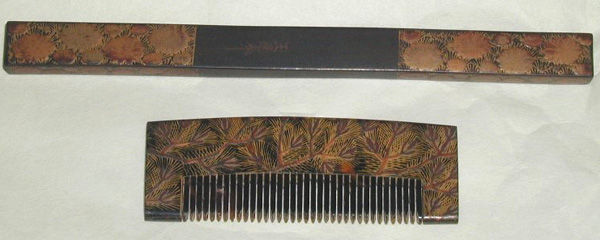
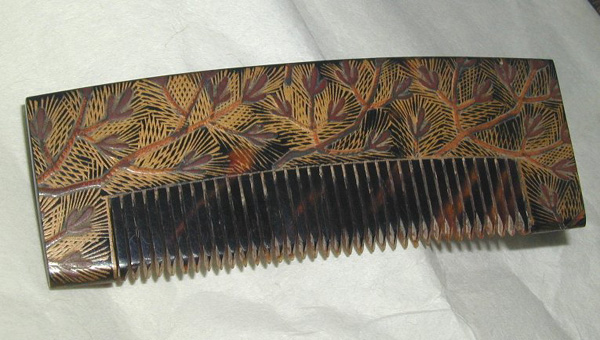
The second set had coral beads set into the kushi and kogai, as the gold maki-e decoration of flowers and leaves almost gives it the look of Imari porcelain. The kogai stick has beautiful gold and silver mounts that attach the oramental shell pieces to the stick itself. It sold for $1100 on August 2. You may refer to item #300135266043.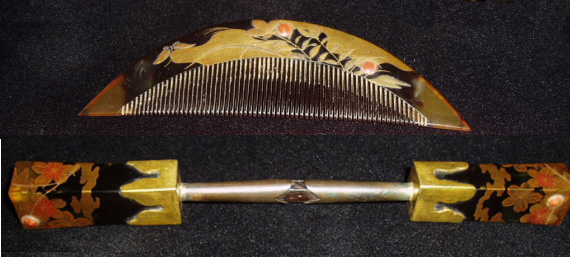
This beautiful Sterling silver comb with filigree leaves sold for $260 on July 30. I think it might be French, but I’m not sure. Comments welcome on this. I thought the design was distinctive and well balanced. You may refer to Item #160140008982.
And finally today, I’ll show a comb a friend gave me pictures of. The dealer who showed it to her wanted $1200, and she is still undecided. It’s a beautiful Japanese Sterling silver, signed comb with a fish swimming in the water. Looking at the shape and size, I think it’s Meiji, although the design — one idea, and a fish — harks back to the Edo period. Comments welcome on this.